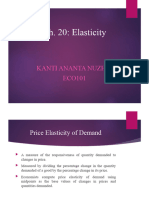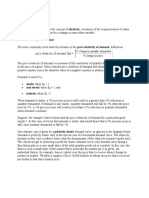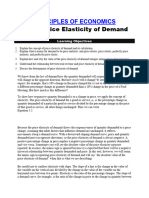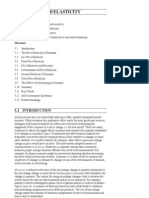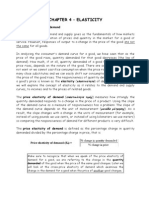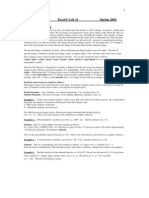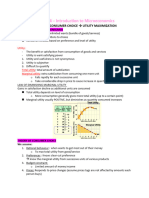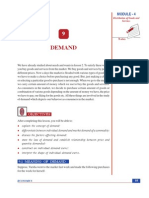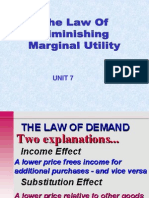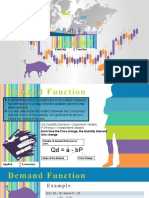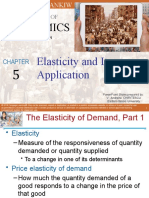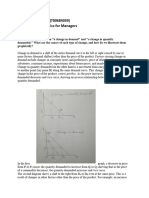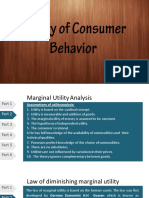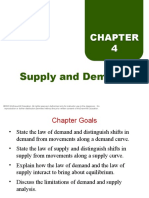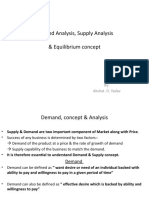0 ratings0% found this document useful (0 votes)
46 viewsWhat Is Elasticity?
What Is Elasticity?
Uploaded by
Krishno RaeElasticity measures the responsiveness of one variable to changes in another. Specifically, elasticity is calculated as the percentage change in one variable divided by the percentage change in the other variable. The document provides examples of how to calculate the price elasticity of demand, price elasticity of supply, and income elasticity of demand using data from charts. It also explains how to interpret whether demand or supply is elastic or inelastic based on whether the elasticity value is greater than, equal to, or less than one.
Copyright:
© All Rights Reserved
Available Formats
Download as DOCX, PDF, TXT or read online from Scribd
What Is Elasticity?
What Is Elasticity?
Uploaded by
Krishno Rae0 ratings0% found this document useful (0 votes)
46 views6 pagesElasticity measures the responsiveness of one variable to changes in another. Specifically, elasticity is calculated as the percentage change in one variable divided by the percentage change in the other variable. The document provides examples of how to calculate the price elasticity of demand, price elasticity of supply, and income elasticity of demand using data from charts. It also explains how to interpret whether demand or supply is elastic or inelastic based on whether the elasticity value is greater than, equal to, or less than one.
Original Description:
Elasticity is . . .
Original Title
What is Elasticity?
Copyright
© © All Rights Reserved
Available Formats
DOCX, PDF, TXT or read online from Scribd
Share this document
Did you find this document useful?
Is this content inappropriate?
Elasticity measures the responsiveness of one variable to changes in another. Specifically, elasticity is calculated as the percentage change in one variable divided by the percentage change in the other variable. The document provides examples of how to calculate the price elasticity of demand, price elasticity of supply, and income elasticity of demand using data from charts. It also explains how to interpret whether demand or supply is elastic or inelastic based on whether the elasticity value is greater than, equal to, or less than one.
Copyright:
© All Rights Reserved
Available Formats
Download as DOCX, PDF, TXT or read online from Scribd
Download as docx, pdf, or txt
0 ratings0% found this document useful (0 votes)
46 views6 pagesWhat Is Elasticity?
What Is Elasticity?
Uploaded by
Krishno RaeElasticity measures the responsiveness of one variable to changes in another. Specifically, elasticity is calculated as the percentage change in one variable divided by the percentage change in the other variable. The document provides examples of how to calculate the price elasticity of demand, price elasticity of supply, and income elasticity of demand using data from charts. It also explains how to interpret whether demand or supply is elastic or inelastic based on whether the elasticity value is greater than, equal to, or less than one.
Copyright:
© All Rights Reserved
Available Formats
Download as DOCX, PDF, TXT or read online from Scribd
Download as docx, pdf, or txt
You are on page 1of 6
Elasticity
"Elasticity is a measure of responsiveness. The responsiveness of behavior measured by variable Z to a change in
environment variable Y is the change in Z observed in response to a change in Y. Specifically, this approximation is
common:
elasticity = (percentage change in Z) / (percentage change in Y)
The smaller the percentage change in Y is practical, the better the measure is and the closer it is to the intended
theoretically perfect measure."
The key thing to understand is that we use elasticity when we want to see how one thing changes when we change
something else. How does demand for a good change when we change its price? How does the demand for a good
change when the price of a substitute good changes?
The Price Elasticity of Demand (commonly known as just price elasticity) measures the rate of response of quantity
demanded due to a price change.
The formula for the Price Elasticity of Demand (PEoD) is:
PEoD = (% Change in Quantity Demanded)/(% Change in Price)
Calculating the Price Elasticity of Demand
"Given the following data, calculate the price elasticity of demand when the price changes from $9.00 to $10.00"
First we'll need to find the data we need. We know that the original price is $9 and the new price is $10, so we have
Price(OLD)=$9 and Price(NEW)=$10. From the chart we see that the quantity demanded when the price is $9 is 150 and
when the price is $10 is 110. Since we're going from $9 to $10, we have QDemand(OLD)=150 and QDemand(NEW)=110,
where "QDemand" is short for "Quantity Demanded". So we have:
Price(OLD)=9
Price(NEW)=10
QDemand(OLD)=150
QDemand(NEW)=110
To calculate the price elasticity, we need to know what the percentage change in quantity demand is and what the
percentage change in price is. It's best to calculate these one at a time.
Calculating the Percentage Change in Quantity Demanded
FORMULA:
[QDemand(NEW) - QDemand(OLD)] / QDemand(OLD)
By filling in the values we wrote down, we get:
[110 - 150] / 150 = (-40/150) = -0.2667
We note that % Change in Quantity Demanded = -0.2667 (We leave this in decimal terms. In percentage terms this
would be -26.67%). Now we need to calculate the percentage change in price.
Calculating the Percentage Change in Price
FORMULA:
[Price(NEW) - Price(OLD)] / Price(OLD)
By filling in the values we wrote down, we get:
[10 - 9] / 9 = (1/9) = 0.1111
We have both the percentage change in quantity demand and the percentage change in price, so we can calculate the
price elasticity of demand.
Final Step of Calculating the Price Elasticity of Demand
We go back to our formula of:
PEoD = (% Change in Quantity Demanded)/(% Change in Price)
We can now fill in the two percentages in this equation using the figures we calculated earlier.
PEoD = (-0.2667)/(0.1111) = -2.4005
When we analyze price elasticities we're concerned with their absolute value, so we ignore the negative value. We
conclude that the price elasticity of demand when the price increases from $9 to $10 is 2.4005.
How Do We Interpret the Price Elasticity of Demand?
A good economist is not just interested in calculating numbers. The number is a means to an end; in the case of price
elasticity of demand it is used to see how sensitive the demand for a good is to a price change. The higher the price
elasticity, the more sensitive consumers are to price changes. A very high price elasticity suggests that when the price of
a good goes up, consumers will buy a great deal less of it and when the price of that good goes down, consumers will
buy a great deal more. A very low price elasticity implies just the opposite, that changes in price have little influence on
demand.
Often an assignment or a test will ask you a follow up question such as "Is the good price elastic or inelastic between $9
and $10". To answer that question, you use the following rule of thumb:
If PEoD > 1 then Demand is Price Elastic (Demand is sensitive to price changes)
If PEoD = 1 then Demand is Unit Elastic
If PEoD < 1 then Demand is Price Inelastic (Demand is not sensitive to price changes)
Recall that we always ignore the negative sign when analyzing price elasticity, so PEoD is always positive. In the case of
our good, we calculated the price elasticity of demand to be 2.4005, so our good is price elastic and thus demand is very
sensitive to price changes.
Data
Price Quantity Demanded Quantity Supplied
$7 200 50
$8 180 90
$9 150 150
$10 110 210
$11 60 250
The Price Elasticity of Supply measures the rate of response of quantity demand due to a price change. If you've already
read The Price Elasticity of Demand and understand it, you may want to just skim this section, as the calculations are similar.
(Your course may use the more complicated Arc Price Elasticity of Supply formula. If so you'll need to see the article
on Arc Elasticity) We calculate the Price Elasticity of Supply by the formula:
PEoS = (% Change in Quantity Supplied)/(% Change in Price)
Calculating the Price Elasticity of Supply
You may be asked "Given the following data, calculate the price elasticity of supply when the price changes from $9.00
to $10.00" Using the chart on the bottom of the page, I'll walk you through answering this question.
First we need to find the data we need. We know that the original price is $9 and the new price is $10, so we have
Price(OLD)=$9 and Price(NEW)=$10. From the chart we see that the quantity supplied (make sure to look at the supply
data, not the demand data) when the price is $9 is 150 and when the price is $10 is 110. Since we're going from $9 to
$10, we have QSupply(OLD)=150 and QSupply(NEW)=210, where "QSupply" is short for "Quantity Supplied". So we
have:
Price(OLD)=9
Price(NEW)=10
QSupply(OLD)=150
QSupply(NEW)=210
To calculate the price elasticity, we need to know what the percentage change in quantity supply is and what the
percentage change in price is. It's best to calculate these one at a time.
Calculating the Percentage Change in Quantity Supply
The formula used to calculate the percentage change in quantity supplied is:
[QSupply(NEW) - QSupply(OLD)] / QSupply(OLD)
By filling in the values we wrote down, we get:
[210 - 150] / 150 = (60/150) = 0.4
So we note that % Change in Quantity Supplied = 0.4 (This is in decimal terms. In percentage terms it would be 40%).
Now we need to calculate the percentage change in price.
Calculating the Percentage Change in Price
Similar to before, the formula used to calculate the percentage change in price is:
[Price(NEW) - Price(OLD)] / Price(OLD)
By filling in the values we wrote down, we get:
[10 - 9] / 9 = (1/9) = 0.1111
We have both the percentage change in quantity supplied and the percentage change in price, so we can calculate the
price elasticity of supply.
Final Step of Calculating the Price Elasticity of Supply
We go back to our formula of:
PEoS = (% Change in Quantity Supplied)/(% Change in Price)
We now fill in the two percentages in this equation using the figures we calculated.
PEoD = (0.4)/(0.1111) = 3.6
When we analyze price elasticities we're concerned with the absolute value, but here that is not an issue since we have a
positive value. We conclude that the price elasticity of supply when the price increases from $9 to $10 is 3.6.
How Do We Interpret the Price Elasticity of Supply?
The price elasticity of supply is used to see how sensitive the supply of a good is to a price change. The higher the price
elasticity, the more sensitive producers and sellers are to price changes. A very high price elasticity suggests that when
the price of a good goes up, sellers will supply a great deal less of the good and when the price of that good goes down,
sellers will supply a great deal more. A very low price elasticity implies just the opposite, that changes in price have little
influence on supply.
Often you'll have the follow up question "Is the good price elastic or inelastic between $9 and $10". To answer that, use
the following rule of thumb:
If PEoS > 1 then Supply is Price Elastic (Supply is sensitive to price changes)
If PEoS = 1 then Supply is Unit Elastic
If PEoS < 1 then Supply is Price Inelastic (Supply is not sensitive to price changes)
Recall that we always ignore the negative sign when analyzing price elasticity, so PEoS is always positive. In our case, we
calculated the price elasticity of supply to be 3.6, so our good is price elastic and thus supply is very sensitive to price
changes.
Data
Price Quantity Demanded Quantity Supplied
$7 200 50
$8 180 90
$9 150 150
$10 110 210
$11 60 250
The Income Elasticity of Demand measures the rate of response of quantity demand due to a raise (or lowering) in a
consumers income. The formula for the Income Elasticity of Demand (IEoD) is given by:
IEoD = (% Change in Quantity Demanded)/(% Change in Income)
Calculating the Income Elasticity of Demand
On an assignment or a test, you might be asked "Given the following data, calculate the income elasticity of demand
when a consumer's income changes from $40,000 to $50,000". (Your course may use the more complicated Arc Income
Elasticity of Demand formula. If so you'll need to see the article on Arc Elasticity)Using the chart on the bottom of the page,
I'll walk you through answering this question.
The first thing we'll do is find the data we need. We know that the original income is $40,000 and the new price is
$50,000 so we have Income(OLD)=$40,000 and Income(NEW)=$50,000. From the chart we see that the quantity
demanded when income is $40,000 is 150 and when the price is $50,000 is 180. Since we're going from $40,000 to
$50,000 we have QDemand(OLD)=150 and QDemand(NEW)=180, where "QDemand" is short for "Quantity Demanded".
So you should have these four figures written down:
Income(OLD)=40,000
Income(NEW)=50,000
QDemand(OLD)=150
QDemand(NEW)=180
To calculate the price elasticity, we need to know what the percentage change in quantity demand is and what the
percentage change in price is. It's best to calculate these one at a time.
Calculating the Percentage Change in Quantity Demanded
The formula used to calculate the percentage change in quantity demanded is:
[QDemand(NEW) - QDemand(OLD)] / QDemand(OLD)
By filling in the values we wrote down, we get:
[180 - 150] / 150 = (30/150) = 0.2
So we note that % Change in Quantity Demanded = 0.2 (We leave this in decimal terms. In percentage terms this would
be 20%) and we save this figure for later. Now we need to calculate the percentage change in price.
Calculating the Percentage Change in Income
Similar to before, the formula used to calculate the percentage change in income is:
[Income(NEW) - Income(OLD)] / Income(OLD)
By filling in the values we wrote down, we get:
[50,000 - 40,000] / 40,000 = (10,000/40,000) = 0.25
We have both the percentage change in quantity demand and the percentage change in income, so we can calculate the
income elasticity of demand.
Final Step of Calculating the Income Elasticity of Demand
We go back to our formula of:
IEoD = (% Change in Quantity Demanded)/(% Change in Income)
We can now fill in the two percentages in this equation using the figures we calculated earlier.
IEoD = (0.20)/(0.25) = 0.8
Unlike price elasticities, we do care about negative values, so do not drop the negative sign if you get one. Here we have
a positive price elasticity, and we conclude that the income elasticity of demand when income increases from $40,000 to
$50,000 is 0.8.
How Do We Interpret the Income Elasticity of Demand?
Income elasticity of demand is used to see how sensitive the demand for a good is to an income change. The higher the
income elasticity, the more sensitive demand for a good is to income changes. A very high income elasticity suggests
that when a consumer's income goes up, consumers will buy a great deal more of that good. A very low price elasticity
implies just the opposite, that changes in a consumer's income has little influence on demand.
Often an assignment or a test will ask you the follow up question "Is the good a luxury good, a normal good, or an
inferior good between the income range of $40,000 and $50,000?" To answer that use the following rule of thumb:
If IEoD > 1 then the good is a Luxury Good and Income Elastic
If IEoD < 1 and IEOD > 0 then the good is a Normal Good and Income Inelastic
If IEoD < 0 then the good is an Inferior Good and Negative Income Inelastic
In our case, we calculated the income elasticity of demand to be 0.8 so our good is income inelastic and a normal good
and thus demand is not very sensitive to income changes.
Data
Income Quantity Demanded
$20,000 60
$30,000 110
$40,000 150
$50,000 180
$60,000 200
The Cross-Price Elasticity of Demand measures the rate of response of quantity demanded of one good, due to a price
change of another good. If two goods are substitutes, we should expect to see consumers purchase more of one good
when the price of its substitute increases. Similarly if the two goods are complements, we should see a price rise in one
good cause the demand for both goods to fall. Your course may use the more complicated Arc Cross-Price Elasticity of
Demand formula. If so you'll need to see the article on Arc Elasticity. The common formula for the Cross-Price Elasticity
of Demand (CPEoD) is given by:
CPEoD = (% Change in Quantity Demand for Good X)/(% Change in Price for Good Y)
Calculating the Cross-Price Elasticity of Demand
You're given the question: "With the following data, calculate the cross-price elasticity of demand for good X when the
price of good Y changes from $9.00 to $10.00." Using the chart on the bottom of the page, we'll answer this question.
We know that the original price of Y is $9 and the new price of Y is $10, so we have Price(OLD)=$9 and Price(NEW)=$10.
From the chart we see that the quantity demanded of X when the price of Y is $9 is 150 and when the price is $10 is 190.
Since we're going from $9 to $10, we have QDemand(OLD)=150 and QDemand(NEW)=190. You should have these four
figures written down:
Price(OLD)=9
Price(NEW)=10
QDemand(OLD)=150
QDemand(NEW)=190
To calculate the cross-price elasticity, we need to calculate the percentage change in quantity demanded and the
percentage change in price. We'll calculate these one at a time.
Calculating the Percentage Change in Quantity Demanded of Good X
The formula used to calculate the percentage change in quantity demanded is:
[QDemand(NEW) - QDemand(OLD)] / QDemand(OLD)
By filling in the values we wrote down, we get:
[190 - 150] / 150 = (40/150) = 0.2667
So we note that % Change in Quantity Demanded = 0.2667 (This in decimal terms. In percentage terms this would be
26.67%).
Calculating the Percentage Change in Price of Good Y
The formula used to calculate the percentage change in price is:
[Price(NEW) - Price(OLD)] / Price(OLD)
We fill in the values and get:
[10 - 9] / 9 = (1/9) = 0.1111
We have our percentage changes, so we can complete the final step of calculating the cross-price elasticity of demand.
Final Step of Calculating the Cross-Price Elasticity of Demand
We go back to our formula of:
CPEoD = (% Change in Quantity Demanded of Good X)/(% Change in Price of Good Y)
We can now get this value by using the figures we calculated earlier.
CPEoD = (0.2667)/(0.1111) = 2.4005
We conclude that the cross-price elasticity of demand for X when the price of Y increases from $9 to $10 is 2.4005.
How Do We Interpret the Cross-Price Elasticity of Demand?
The cross-price elasticity of demand is used to see how sensitive the demand for a good is to a price change of another
good. A high positive cross-price elasticity tells us that if the price of one good goes up, the demand for the other good
goes up as well. A negative tells us just the opposite, that an increase in the price of one good causes a drop in the
demand for the other good. A small value (either negative or positive) tells us that there is little relation between the
two goods.
Often an assignment or a test will ask you a follow up question such as "Are the two goods complements or
substitutes?". To answer that question, you use the following rule of thumb:
If CPEoD > 0 then the two goods are substitutes
If CPEoD =0 then the two goods are independent (no relationship between the two goods
If CPEoD < 0 then the two goods are complements
In the case of our good, we calculated the cross-price elasticity of demand to be 2.4005, so our two goods are
substitutes when the price of good Y is between $9 and $10.
You might also like
- Problem Set 6Document2 pagesProblem Set 6FarizNo ratings yet
- Economics for CFA 2024: level 1 in just one week: CFA level 1, #4From EverandEconomics for CFA 2024: level 1 in just one week: CFA level 1, #4Rating: 4.5 out of 5 stars4.5/5 (2)
- Price Elasticity of DemandDocument23 pagesPrice Elasticity of Demandwikeeshah100% (3)
- Business Economics Chapter 2 - Demand AnalysisDocument44 pagesBusiness Economics Chapter 2 - Demand Analysissharukh kapadiaNo ratings yet
- Calculating The Price Elasticity of DemandDocument13 pagesCalculating The Price Elasticity of DemandRoubonNo ratings yet
- Income Elasticity of DemandDocument8 pagesIncome Elasticity of Demandសារុន កែវវរលក្ខណ៍No ratings yet
- Price Elasticity of Supply and DemandDocument4 pagesPrice Elasticity of Supply and DemandRosSimbulanNo ratings yet
- Calculus Price ElasticityDocument6 pagesCalculus Price ElasticityAnish181No ratings yet
- Elasticity: in Economics, Elasticity Is The Measurement of How Changing One Economic Variable Affects Others. andDocument36 pagesElasticity: in Economics, Elasticity Is The Measurement of How Changing One Economic Variable Affects Others. andFidez PerezNo ratings yet
- Data Price Quantity Demanded Quantity SuppliedDocument21 pagesData Price Quantity Demanded Quantity SuppliednitinthelibranNo ratings yet
- P in Brief, Are As Under:: 0 in Developing Countries of The World, TheDocument4 pagesP in Brief, Are As Under:: 0 in Developing Countries of The World, TheEmilia Visaya NacuaNo ratings yet
- Calculating Price Elasticity of DemandDocument8 pagesCalculating Price Elasticity of DemandSaifullah RussellNo ratings yet
- Cross Price ElasticityDocument6 pagesCross Price ElasticityRavi KumudeshNo ratings yet
- Elasticity of DemandDocument2 pagesElasticity of DemandVarun KalseNo ratings yet
- Price Elasticity of Supply and Its DeterminantsDocument18 pagesPrice Elasticity of Supply and Its DeterminantsJohn Angelo MirandaNo ratings yet
- Elasticity of DemandDocument2 pagesElasticity of DemandVarun KalseNo ratings yet
- Me 4pptDocument55 pagesMe 4pptarchana_anuragiNo ratings yet
- Lecture 03 - Elasticity of Demand and SupplyDocument60 pagesLecture 03 - Elasticity of Demand and SupplyTanveer Khan100% (2)
- CH 05Document55 pagesCH 05Mirco SoffrittiNo ratings yet
- Elasticity of Demand and Supply: Assignment No. 3Document6 pagesElasticity of Demand and Supply: Assignment No. 3jp ednapilNo ratings yet
- CH 20 ElasticityDocument28 pagesCH 20 ElasticityEshrat Tarabi Shimla 2211281030No ratings yet
- Economics CT2Document192 pagesEconomics CT2EE19B1004 ADENA VISHNU VARDHAN REDDYNo ratings yet
- Be 313 - Unit Learning CDocument19 pagesBe 313 - Unit Learning Cmhel cabigonNo ratings yet
- Case On ElastisityDocument8 pagesCase On ElastisityFarah AhmedNo ratings yet
- Elasticity of SupplyDocument8 pagesElasticity of SupplyRolly HornadaNo ratings yet
- Elasticity - DemandDocument31 pagesElasticity - Demandnavin aslam jumaniNo ratings yet
- Economics For Managers GTU MBA Sem 1 Chapter 05Document38 pagesEconomics For Managers GTU MBA Sem 1 Chapter 05Rushabh VoraNo ratings yet
- Elasticityof DemandDocument5 pagesElasticityof DemandSahiti DarikaNo ratings yet
- Chapter 4 Labor Demand ElasticityDocument10 pagesChapter 4 Labor Demand ElasticityGold UsenekongNo ratings yet
- Pe 451 - Lecture 2Document14 pagesPe 451 - Lecture 2obodyqwerty123No ratings yet
- Elasticity of DemandDocument16 pagesElasticity of DemandUmamaheswari Rajan100% (1)
- Elasticity of Demand: Price, Income and Cross ElasticityDocument59 pagesElasticity of Demand: Price, Income and Cross Elasticitynithinsp92No ratings yet
- Price Elasticitiy of DemandDocument5 pagesPrice Elasticitiy of Demandsara24391No ratings yet
- Price Elasticity of Demand: Elastic When E Unit Elastic When E Inelastic When EDocument11 pagesPrice Elasticity of Demand: Elastic When E Unit Elastic When E Inelastic When ESnigdhaNo ratings yet
- Price ElasticityDocument34 pagesPrice Elasticitykamakshigehlot05No ratings yet
- Ch05 Mankiw Micro7Ce Fall2020 DesignDocument52 pagesCh05 Mankiw Micro7Ce Fall2020 Designseenthebean2001No ratings yet
- Price Elasticity of DemandDocument5 pagesPrice Elasticity of DemandManoj KNo ratings yet
- Price Elasticity of Demand (PED or E: Economics Percent ChangeDocument3 pagesPrice Elasticity of Demand (PED or E: Economics Percent ChangemustafakarimNo ratings yet
- It ProjectDocument2 pagesIt ProjectSapna SharmaNo ratings yet
- Business EconomicsDocument12 pagesBusiness EconomicsRajni Kumari100% (3)
- The Elasticity of DemandDocument53 pagesThe Elasticity of DemandShekhar SinghNo ratings yet
- Principles of EconomicsDocument20 pagesPrinciples of EconomicsAman KedirNo ratings yet
- The Price Elasticity of Demand: A.) What Is "Demand Elasticity," and What Determines It?Document5 pagesThe Price Elasticity of Demand: A.) What Is "Demand Elasticity," and What Determines It?irfan_rasheed_16No ratings yet
- Elasticidade-Preço Da ProcuraDocument26 pagesElasticidade-Preço Da ProcuraAnabela Pinto SilvaNo ratings yet
- Unit 5Document17 pagesUnit 5Gulshan GuptaNo ratings yet
- Applied Economics - 1st-QRTR - PPT - 5Document63 pagesApplied Economics - 1st-QRTR - PPT - 5Agnes RamoNo ratings yet
- Elasticity and Its ApplicationsDocument44 pagesElasticity and Its ApplicationsFahadNo ratings yet
- Elasticities of Demand and SupplyDocument54 pagesElasticities of Demand and SupplyAppleCorpuzDelaRosa100% (2)
- Elasticity EconomicsDocument14 pagesElasticity EconomicsYiwen LiuNo ratings yet
- Objectives: Price Elasticity of Demand Determinants of EdDocument11 pagesObjectives: Price Elasticity of Demand Determinants of EdGenious PrinceNo ratings yet
- Chapter 4 - Elasticity: I. Price Elasticity of DemandDocument29 pagesChapter 4 - Elasticity: I. Price Elasticity of DemandArunkumarNo ratings yet
- Elasticity of Demand and Supply: ObjectivesDocument11 pagesElasticity of Demand and Supply: ObjectivesJoanne FerrerNo ratings yet
- Market Demand and ElasticitiesDocument46 pagesMarket Demand and Elasticitiespdm88hd4bsNo ratings yet
- 04 Elasticity of DemandDocument17 pages04 Elasticity of DemandrahulbawaNo ratings yet
- Unit 4 - Elasticity: Elasticity Is A Relative Change in Economic Variables Such As Price, Demand and SupplyDocument32 pagesUnit 4 - Elasticity: Elasticity Is A Relative Change in Economic Variables Such As Price, Demand and SupplyLillian NgubaniNo ratings yet
- Elasticity-Of-Demand 8552087 PowerpointDocument21 pagesElasticity-Of-Demand 8552087 PowerpointChandan NNo ratings yet
- Price Elasticity Week 5Document38 pagesPrice Elasticity Week 5Katrina LabisNo ratings yet
- Elasticity of Demand and SupplyDocument27 pagesElasticity of Demand and SupplyMuskan FatimaNo ratings yet
- Chap 4 ElasticityDocument14 pagesChap 4 ElasticityLâmViênNo ratings yet
- L11'25Document3 pagesL11'25locomotivetrackNo ratings yet
- 4 Demand AnalysisDocument30 pages4 Demand Analysisমোহাম্মাদ রাশেদুর রহমান রাশেদNo ratings yet
- Various Methods of Price Elasticity of DemandDocument9 pagesVarious Methods of Price Elasticity of Demandsalim132150% (2)
- MCQ InstructionsDocument4 pagesMCQ InstructionsKrishno RaeNo ratings yet
- Case ConceptualizationDocument18 pagesCase ConceptualizationKrishno RaeNo ratings yet
- Counselling Micro Skills: Chapter 1 - IntroductionDocument11 pagesCounselling Micro Skills: Chapter 1 - IntroductionKrishno RaeNo ratings yet
- Chapter 3 - Basic Attending Basic Attending and Listening Skills and Listening SkillsDocument9 pagesChapter 3 - Basic Attending Basic Attending and Listening Skills and Listening SkillsKrishno RaeNo ratings yet
- Cost of Production: Fixed and Variable CostsDocument4 pagesCost of Production: Fixed and Variable CostsKrishno Rae100% (1)
- Ainembabazi PreciousDocument5 pagesAinembabazi PrecioussdgsfgdgNo ratings yet
- CECN 104 CH 7Document9 pagesCECN 104 CH 7ariannaNo ratings yet
- Consumer Theory Burkey AcademyDocument1 pageConsumer Theory Burkey AcademymazamniaziNo ratings yet
- ConsumerTheory ProblemsDocument1 pageConsumerTheory ProblemsTrúc Duyên Huỳnh NguyễnNo ratings yet
- The Indifference Curve AnalysisDocument17 pagesThe Indifference Curve AnalysisRishab Jain 2027203100% (1)
- Chapter 9Document13 pagesChapter 9ayandasmtsNo ratings yet
- Chapter 04 Elasticity QuestionsDocument15 pagesChapter 04 Elasticity QuestionsErjon Skordha100% (2)
- Elasticity of DemandDocument21 pagesElasticity of DemandPriya Kala100% (1)
- Lecture16-Price Elasticity of DemandDocument50 pagesLecture16-Price Elasticity of DemandSergio VinsennauNo ratings yet
- Cardinal Utility TheoryDocument35 pagesCardinal Utility TheorySyeda Uzma TauqirNo ratings yet
- Consumer'S Equilibrium: TU U + U + U UDocument10 pagesConsumer'S Equilibrium: TU U + U + U UAnmol ChawlaNo ratings yet
- Eoc 5Document12 pagesEoc 5Maiwand BabakarkhailNo ratings yet
- CHOICEDocument9 pagesCHOICEtegegn mogessieNo ratings yet
- Demand Elasticity and FunctionDocument21 pagesDemand Elasticity and FunctionBrickson DimasNo ratings yet
- Math of ECoNoMIcsDocument3 pagesMath of ECoNoMIcsPham Phu Cuong B2108182No ratings yet
- Chapter 5 Elasticity and Its ApplicationDocument41 pagesChapter 5 Elasticity and Its ApplicationVinh Pham QuangNo ratings yet
- Keynesian SchoolDocument11 pagesKeynesian SchoolAryo RahendraNo ratings yet
- Economics Assignment 1Document3 pagesEconomics Assignment 1GbengaNo ratings yet
- 04 Mixed StrategiesDocument29 pages04 Mixed StrategiesNicolas MarinNo ratings yet
- Consumer BehaviorDocument32 pagesConsumer BehaviorArooj FatimaNo ratings yet
- TPD 501 AssDocument8 pagesTPD 501 AssTomisin EniolaNo ratings yet
- Elasticity of Demand: Academic TutorialsDocument6 pagesElasticity of Demand: Academic TutorialsDixie Cheelo100% (1)
- Colander 11th Edition Ch04 SlidesDocument50 pagesColander 11th Edition Ch04 SlidesSerenay AkgünNo ratings yet
- INTERMIC LPPT Ch4 Lecture Addition 14septDocument64 pagesINTERMIC LPPT Ch4 Lecture Addition 14septUzair ArifNo ratings yet
- Demand Analysis, Supply Analysis & Equilibrium Concept: By: Akshat. D. YadavDocument15 pagesDemand Analysis, Supply Analysis & Equilibrium Concept: By: Akshat. D. YadavyadavakshatNo ratings yet
- Ch-5 Game TheoryDocument14 pagesCh-5 Game Theoryras dawitNo ratings yet
- Neuman and MorgensternDocument32 pagesNeuman and Morgensternvadim3108No ratings yet
- Chapter-2 Man EcoDocument29 pagesChapter-2 Man Ecolyzel kayeNo ratings yet




















